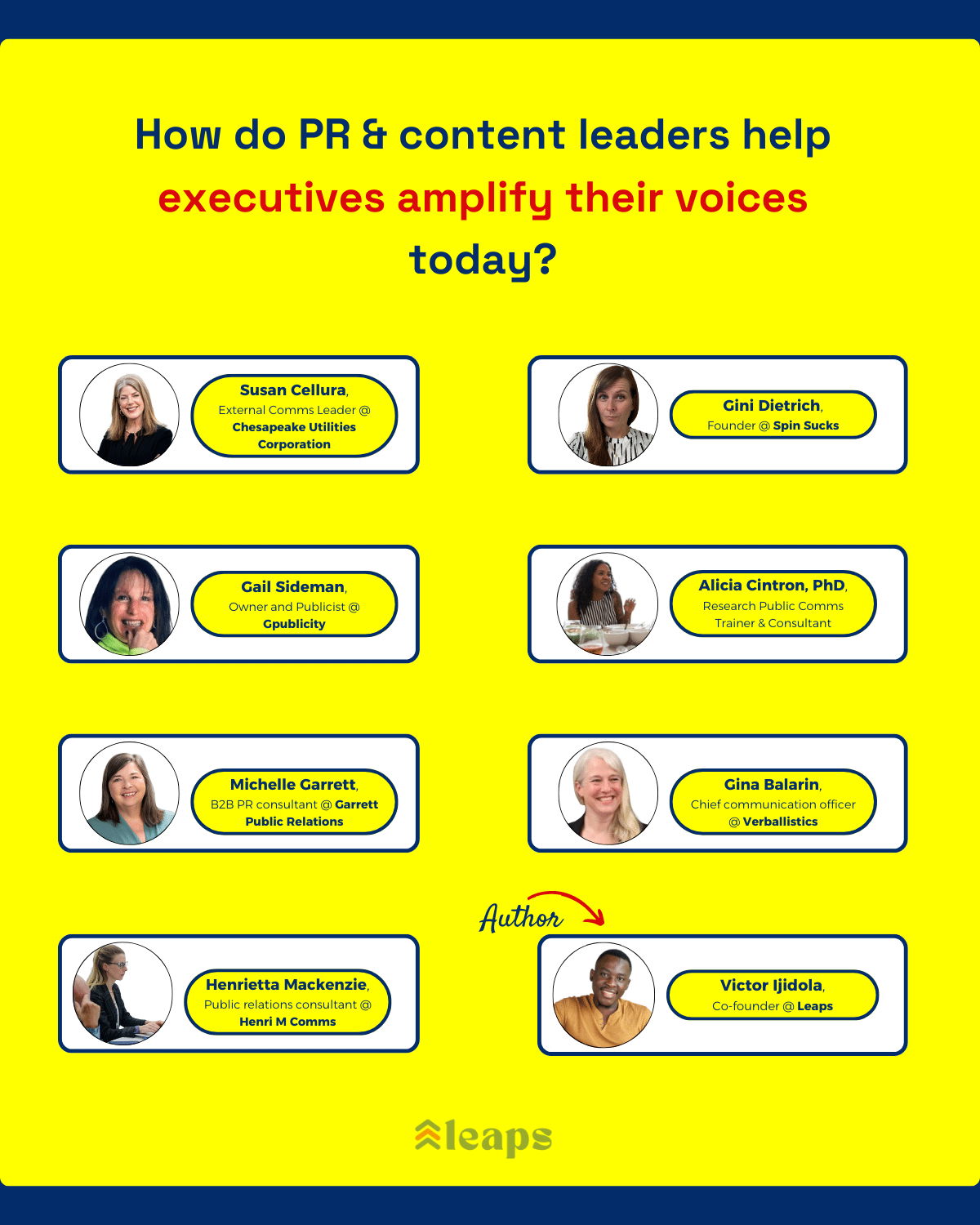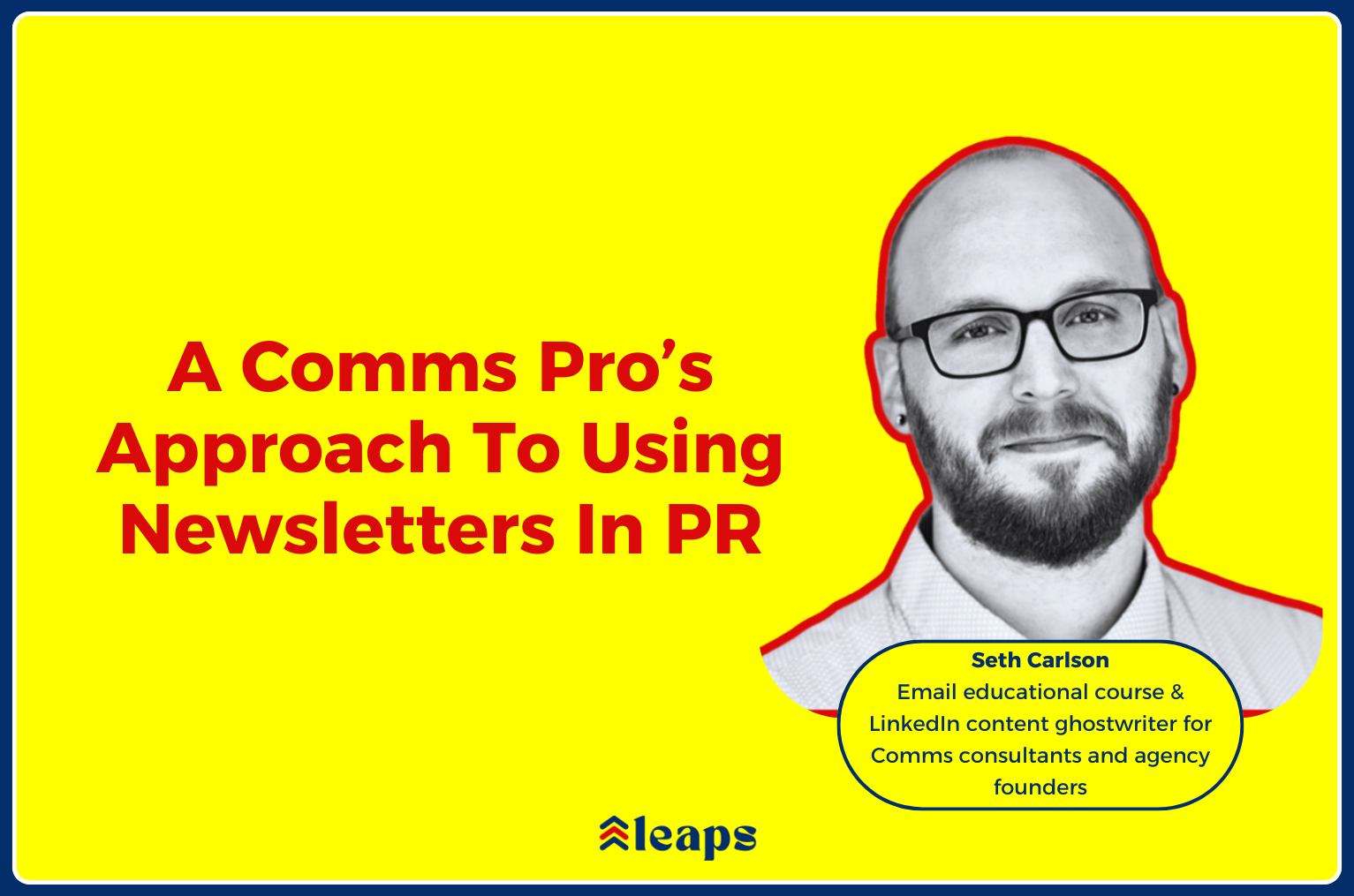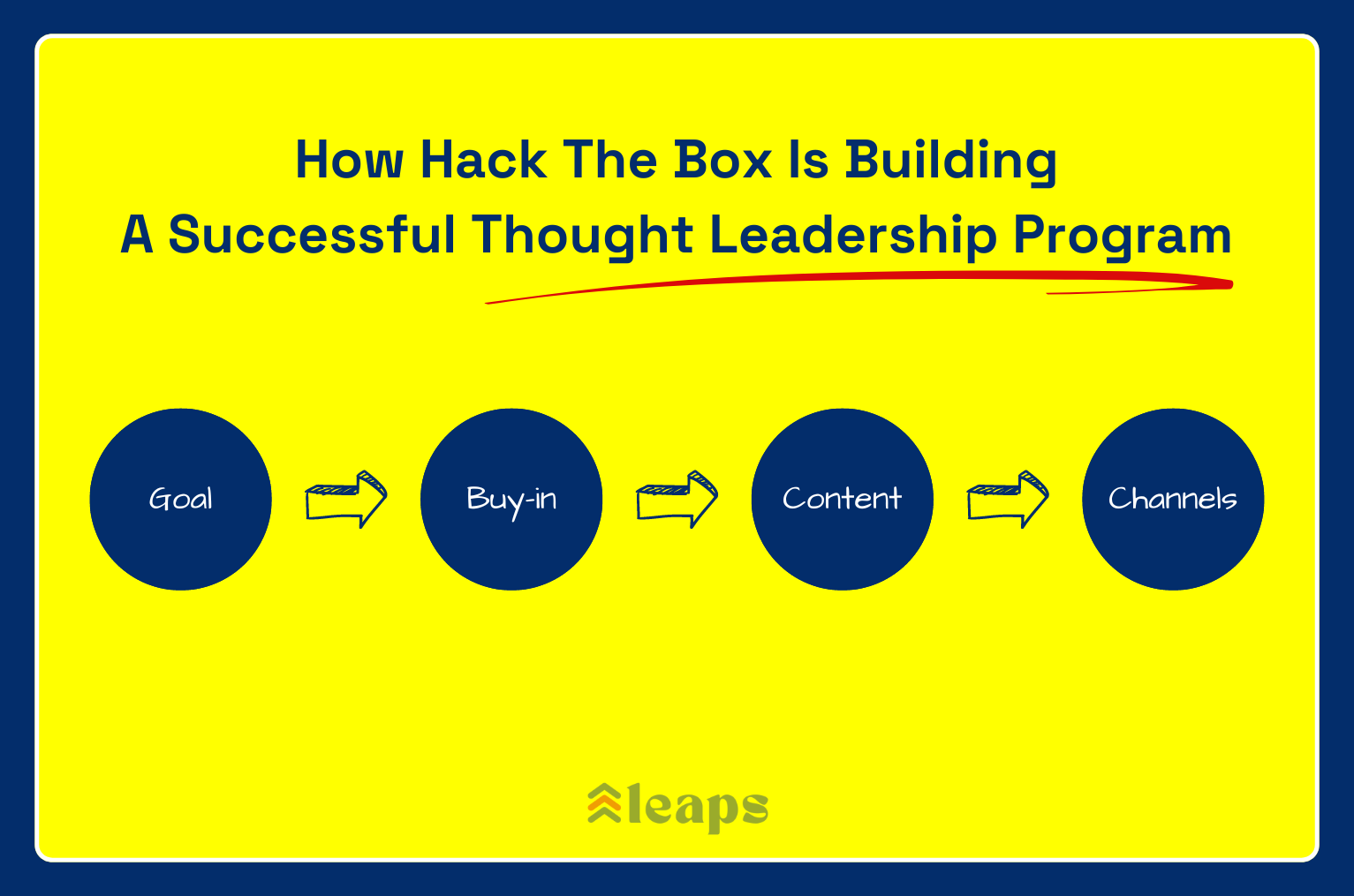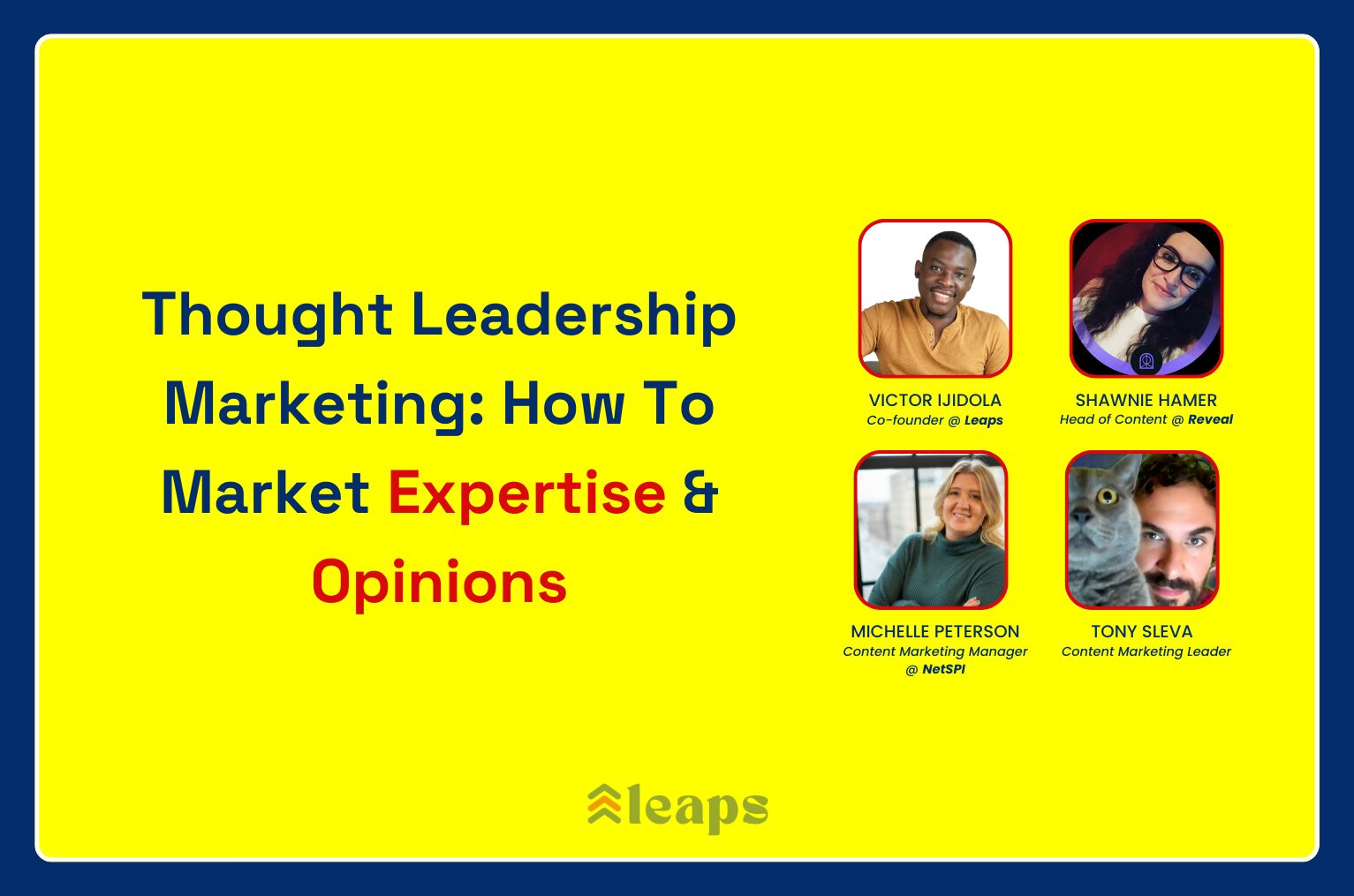
I’ve always been an executive of some sort.
I started out in 2013 running a freelance writing business.
Then transitioned to owning a content agency where I led a team of five.
Now, as a SaaS founder, I run Leaps with my co-founder and wife, Rennie.
Throughout these 10+ years, I’ve had to use executive thought leadership to grow my businesses (on and off) — one way or another.
Meaning I’ve had to show up regularly and share my “leading thoughts” with my audience.
And I’ve mostly done it through blogs, social media, newsletters, and guest posts.
That’s what executive thought leadership is. So today, I’ll be sharing all I know about it.
But you’ll also be learning from folks with even more experience than myself on this topic, so you’re in for a treat!
What’s inside:
Experienced PR and thought leadership pros featured here
Just so you get a bang for your time reading this piece, I’ve used Leaps — yep, our product 😊 — to pull insights from subject matter experts (SMEs) on executive thought leadership.
A BIG thank you to them for saying yes to sharing their insights and doing it:
- Alicia Cintron, PhD — Research public comms trainer & consultant @ Cintron, Revised
- Susan Cellura — External comms leader @ Chesapeake Utilities Corporation
- Gini Dietrich — Founder @ Spin Sucks, training academy for PR & marketing pros
- Gail Sideman — Owner and publicist @ Gpublicity
- Michelle Garrett — B2B PR consultant @ Garrett Public Relations
- Gina Balarin — Chief communication officer @ Verballistics
- Henrietta Mackenzie — Public relations consultant @ Henri M Comms
How do experts do executive thought leadership today?
I’ll be answering this question with insights from our featured experts — and yours truly.
1) First, sell execs on outcomes
Especially if they don’t quite get the need for thought leadership.
You’ll need to paint a clear, convincing picture of what they’ll get out of it.
Otherwise, they won’t go all in or take it seriously enough to hit ROI.
And there are loads of examples you can use to convince them. (I’ll share some in a bit).
For instance, if they’re in construction, show them how construction brands like them are driving attention and interest in their industry.
Alicia Cintron says she starts with painting pictures, showing them how their efforts add up over days and weeks.

Alicia Cintron
Research public comms trainer & consultant @ Cintron, Revised
“Then we work backwards and I show them how working on their thought leadership a little per day and per week adds up, and will help them reach their peak goal in time.”
As Alicia’s executive clients come from the academics and research space, they’re pretty much as far from “getting thought leadership” as anyone can be.
But selling them on the outcomes of being a thought leader helps to close that gap.
2) 100% authenticity is uncomfortable, but lead with it
The temptation to over-polish things we post online is often a strong one.
And it’s understandable. We want to help our execs/clients leave a lasting impression.
So we feel twisting and turning their words, polishing it to sound just perfect, is what they need to sound confident and authoritative, loud and clear. But it’s often not the case.
Susan Cellura agrees this is a common issue.

Susan Cellura
External comms leader @ Chesapeake Utilities Corporation
“It often ends up sounding stiff and inauthentic, like it’s coming from a corporate robot rather than a real person.
““Especially today when people want genuine communications — two-way versus being talked at.”
But that’s just not how our audiences want to receive our messages.
Or as Susan puts it: “It misses the mark on building a true connection with the audience.”
People gravitate towards organic and authentic content.
Content they can relate to. Content that reflects the reality they live in. Authentic content.
Susan recommends coaching executives on the importance of sounding as real as possible:
“I like to coach/educate them as needed on the importance of being themselves — real, relatable, etc., for their target audience(s) but keeping with the brand.
“Instead of scripting everything, let them share their authentic thoughts and experiences. This could be through casual interviews, live Q&A sessions, or even just letting them write in their own voice.
“They know what’s happening in the industry, so help them engage in meaningful ways, like commenting on hot topics or sharing their take on industry challenges. It’s all about making sure their voice is genuine and resonates with people.”
3) AI is helpful, but don’t make it your thought leader
There are very few things today that are easier than prompting AI to create content.
It’s so easy, you hardly need to lift a finger to do it.
Example: just install a chrome extension like Jasper, write a topic, and click Command J.
It’ll keep writing till you tell it to stop.
But that ease of use comes with a cost: a stark and obvious lack of differentiation.
Gini Dietrich pointed out this problem, too:

Gini Dietrich
Founder and CEO @ Spin Sucks
“I’ve even noticed it in LinkedIn comments.
“People can tell you didn’t write that, and it’s not unique to you. It’s not thought leadership.
“For you to have thought leadership, you need to have a thought that is unique to your organization and to your industry.
“It’s up to your PR or content team to ensure those thoughts are extracted from your brain to create true thought leadership.”
Hint: They can use Leaps to extract those insights — without the need to jump on so many calls.
4) Recognize your job is… really… to listen
As content leaders or PR reps, we’re hardly ever experts in the fields we work in.
We can pick things up, gain some experience as we spend years in each of those fields, but we almost never become SMEs there.
Just like a software engineer can hardly ever become a petroleum engineer because they’ve worked for 10 years in an oil company.
So our job is primarily to amplify the voice of the experts in the companies we work for.
But it all starts from doing the hard work of… listening.
This was the idea the owner and publicist of Gpublicity echoed when I asked her to share the steps she typically takes to capture the POVs of execs/SMEs and amplify them in an industry:

Gail Sideman
Owner and publicist @ Gpublicity
“The most important tool is our ears.
“Among the best compliments I’ve received was when a client said I captured his voice better than he did when talking about a complex topic.
“Another was when a client (author) said she cried because I drew out words she needed when challenged to express feelings about a sensitive topic.”
5) Avoid putting execs forward if they’re not qualified
The fact that someone is an executive doesn’t mean they’re qualified to be the face (or one of the faces) of the organization they work in or own.
“Qualified” here means they have to have (A) experience and (B) unique insights and POVs to share with their target audience.
Typical example: the CEO who bought a business in an unfamiliar industry.
They believe in the model and idea of the company, but hardly have experience and unique insights about the industry or audience.
Bottom line: look for people who are truly industry experts and amplify their voices.
I like how Michelle Garrett put it:

Michelle Garrett
B2B PR consultant @ Garrett Public Relations
“To be a thought leader, you have to have either 1) experience in the industry OR 2) unique insight into industry trends/issues — OR both.
“It’s clear pretty quickly if/when someone is sharing the same insight that just about everybody else in a particular space is sharing.
“If you don’t have a unique perspective, I think it’s tough to position yourself (or have your PR person, consultant or agency position you) as a thought leader.”
6) Ask questions that make execs think deeply
I usually say, “the depth of questions you ask determines the depth of answers you get.”
Ask execs shallow ended questions and all you’ll get are 1 to 2-sentence answers.
But deep questions will get them to open up.
And thankfully, most execs already do a lot of deep thinking to do their jobs.
You just need them to “think out loud,” asking them questions that’ll get them to share those deep thoughts.
I like how the chief communication officer at Verballistics put it:

Gina Balarin
Chief communication officer @ Verballistics
“The art of encouraging thought leadership in others is to ask questions that may be uncomfortable, but that provoke deep thought.
“When combined with real-life examples, theory and practical wisdom, thought leaders do what it says on the tin — they think, and they lead.
“So make them comfortable, ask the right questions, capture info and tidy their insights up in a way that allows them to be proud of the outputs.”
7) Make their messaging consistent
Inconsistency is the mother of distrust and confusion — especially in PR, marketing, comms, and content.
Trust is hard to build when one of your executives has a different POV or story from the others on the same issue within the same organization.
And soon after, revenue losses will likely follow — because people buy from brands and people they trust.
But inconsistent messaging usually comes from the lack of a cohesive strategy, as Henrietta Mackenzie points out:

Henrietta Mackenzie
Public relations consultant @ Henri M Comms
“This often stems from a lack of cohesive strategy aligning the executive’s public points of view with the company’s brand and values.”
It’s important for your brand and its executives to keep saying the same things. When that happens over and over, it’ll stick with the audience.
Inconsistent messaging only breeds distrust.
Examples of executive thought leadership we’ve seen around
For inspiration, let’s see some examples of executive thought leadership that experts feel are worth showcasing in this article.
Scott Galloway’s personable, funny, headstrong, and vulnerable content
When Alicia shared this example, I thought “Who’s Scott Galloway?”
So, of course, I checked him out. And he’s just as Alicia described him: very personable, funny, headstrong, and vulnerable.
Once I landed on his blog, I could immediately see some of those attributes in his logo: NO MERCY/NO MALICE.
And then I proceeded to check out his latest blog post about mouse.ai, and the very first line describes Apple Vision Pro as
Alicia was right; that line can only come from some you’d describe as headstrong.
But the important lesson here is Scott is letting his personality shine in his content.
That’s how we show thought leadership. Our experience, personality, and expertise has to show so much that our audience can identify us with them.
XRI’s CEO & COO pushing a new industry solution
In this example, external comms leader Susan Cellura shares how she worked on a campaign to position XRI as the leader in Environmental, Social, and Governance (ESG) in the water midstream sector.
“This company took the initiative to tackle one of the biggest issues in the oil and gas (O&G) sector — water usage,” says Susan.
“Fracking (an oil/gas extraction technique) uses a ton of water,” she continues, “and traditionally, a lot of that water just goes to waste or is disposed underground.”
“But XRI flipped the script. They developed a system to recycle the water used in fracking, so it could be reused over and over by the O&G companies.”
Next, the team went public with this innovation.
They shared detailed numbers that showcased their impact and how their efforts benefited the environment, supported the agricultural industry, and ensured clean drinking water for local communities.
But one important thing to point out here is how XRI’s CEO and COO led the charge amplifying this groundbreaking innovation.
For instance, here’s the CEO — Matthew Gabriel — getting featured on a popular industry publication, Inside Climate News:
And here’s COO Chris Harich doing a field interview with Tomorrow’s World Today; the video has now amassed over 22,000 views.
“The CEO and COO didn’t just sit behind desks,” says Susan.
“They were out there, leading the charge, speaking at conferences, publishing articles, and engaging with the community.”
“They were transparent and constantly communicated their progress and challenges. They showed how to lead by example and build a reputation around sustainable practices during a time when ESG reporting had yet to be mapped out.”
“This also helped their customers as they could take Midland company’s ESG report and add it into their sustainability reports.”
“By taking a proactive stance on such a critical issue, we were able to boost the brand but also set a new standard for ESG in their industry.”
“Now, they’re seen as the go-to leader when it comes to responsible water management in the midstream space. I’m quite proud of the work we did as it shows how thoughtful leadership and a clear, impactful campaign can transform a company’s reputation and lead the way in an industry.”
Ann Handley’s LinkedIn content
LinkedIn probably has millions of novel executive thought leadership examples.
From founders building in public to professionals sharing game-changer POVs to freelancers sharing their struggles and success with their solo businesses, LinkedIn has so many good thought leadership examples from executives.
Or as Gini Dietrich put it, “there is a lot of really good thought leadership happening on LinkedIn right now.”
And she shared some examples, but this one from Ann Handley caught my attention the most:
In an industry where there are two extremes about AI usage, Ann shared a very balanced view on how marketers should approach the topic.
One extreme says they use AI to write all their content, saving lots of time and money.
The other extreme is the school of thought that AI shouldn’t be used at all.
Ann shared her thoughts and introduced a middle ground that objectively works, pointing out stages in the writing process where AI is useful vs. where writers have to take the reins.
Grote CEO’s 2024 prediction for food processing manufacturers
Predicting trends is an age-old strategy for executive thought leadership.
You look at the current landscape of your industry, examine what’s happened in the past, and then predict the future based on observations, expertise, and experience.
Predictions are a pristine example of thought leadership, so when PR consultant Michell shared this one she worked on with Grote’s CEO, it totally made sense.
One thing that made it even more powerful was that she got it published on an industry trade publication — Food Industry Executive.
Grote manufactures and sells food processing equipment, so getting published on a publication read by food industry execs is a big deal.
Even if the piece got read by only 200 people, it can have a serious impact on the business because chances are high that readers are Grote’s potential buyers.
Navigate Ventures’s Managing Partner on TechCrunch
Public relations consultant Henrietta shared this executive thought leadership example of a client she helped get on TechCrunch.
The client: Ivan Nikkhoo, Managing Partner of Navigate Ventures.
“I worked with Ivan to identify the story,” says Henrietta, “then drafted a hard-hitting synopsis to pitch: ‘Team, timing and execution: the trilogy of success.’”
“It had the perfect ingredients for a by-line: topical subject, catchy headline and strong POV. As a result, it took less than an hour to secure.”
If you’re in the tech startup or investment world, you’ll know TechCrunch. So an investor getting published there is a great business opportunity.
They’ll get exposed to a wide audience of startup founders who might read their thoughts and decide to pitch them for an investment.
Wrapping up
Executive thought leadership drives tons of benefits for businesses that engage in it. From brand awareness and industry leadership to customer acquisition & retention and investor relationships, the potential is wide.
But there are definitely right and wrong ways to go about it. This piece emphasizes the former and I put it together to guide you on your way to executing a successful executive thought leadership strategy.
Hi, I’m Victor Ijidola, co-founder @ Leaps, an easy way to get insights from your SMEs — no calls needed — and turn them into detailed, expert-led content briefs and outlines. If we're not connected yet, I'd love to meet you! 🙂



